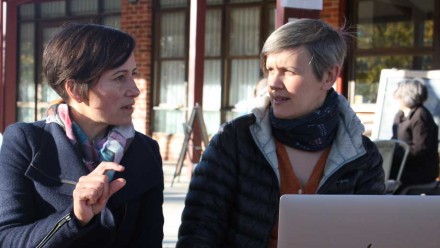New research shows how batteries meet communities’ various energy needs
As Australia’s electricity sector transitions from fossil fuel generation and distribution, it’s become the world leader in per capita installation of solar and wind energy.
But renewables’ variable nature means more storage will be required.
Enter community-based battery storage, which has risen in popularity among communities, industry, and regulators in recent years.
Community batteries provide different services for different groups, says Dr Marnie Shaw, Research Leader in the ANU Battery Storage and Grid Integration Program.
“It can provide storage for customers in potentially a cheaper way because of economies of scale, and they can also provide the kind of support for the grid that we increasingly need as we’re adding more and more solar generation from our rooftops,” Dr Shaw says.
“Shared energy assets like community batteries might be a good way to address some of the equity issues that we need to be mindful of as we transition to a low-carbon energy system.”
Typical community battery storage systems are about 10 times larger than their household equivalent, roughly the size of a shipping container. Some are inside such boxes, others are underground.
Trials to date have occurred only in Western Australia, because electricity companies there are government-owned and aren’t subject to rules governing the eastern states.
“In practice, it means it’s difficult for networks to own a battery on the east coast, because they’re not allowed to buy and sell energy directly to customers,” Dr Shaw adds.
Her team, with funding support from ARENA, seeks to answer the questions: can community batteries operate on Australia’s east coast; who would own and benefit from such systems, and what rules, if any, would need to be changed.
In an extension of the original project, they’re also partnering with ACT distributor EvoEnergy and the ACT Government to explore a project in a future suburb in Canberra that is mandating rooftop solar.
“The goal of this trial will be to work out whether community batteries provide a good way to support very high solar PV penetration,” Dr Shaw says.
Central to the ANU Battery Storage and Grid Integration Program’s focus is engineering and social research side-by-side.
“Because the technical solutions that we develop will only work if you consider at the same time the people who’ll be using them,” Dr Shaw adds.
Colleague, Dr Hedda Ransan-Cooper, says from the outset researchers were interested in access and affordability, and enabling people who’ve been excluded from using renewables to engage more in the transition.
“What we found was that people agreed community batteries could be part of solving the energy trilemma, but they were focused on different benefits and different risks,” the Research Fellow says.
“This makes what pathways that we go with an inherently political question requiring some thought and investment about what kinds of planning processes and regulations we put in place.”
ARENA has provided $498k of funding towards the $1.37m project under their Advancing Renewables program. ANU leads the project with project partners Energy Consumers Australia, Energy Networks Association, Enova Community Energy, RePower Shoalhaven, TasNetworks, Thinking In Colours, Totally Renewable Yackandandah, Evoenergy, and Yurika.











